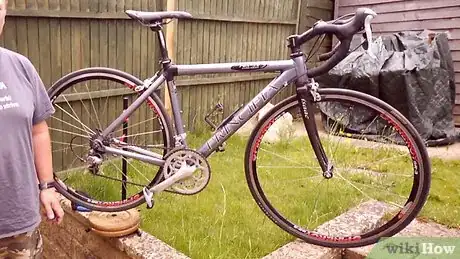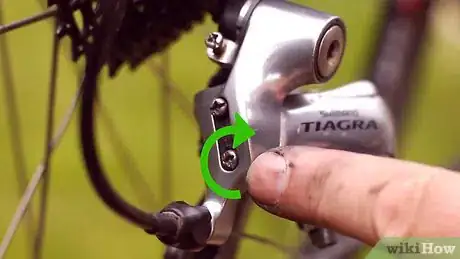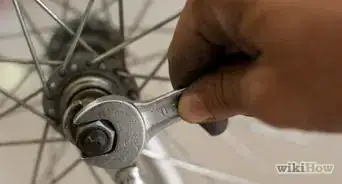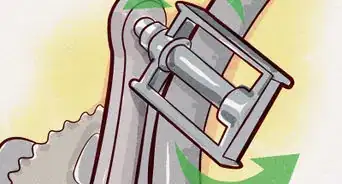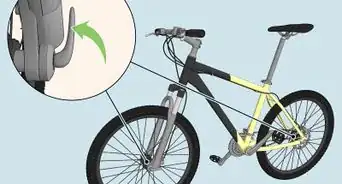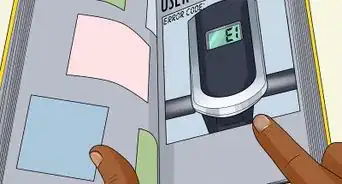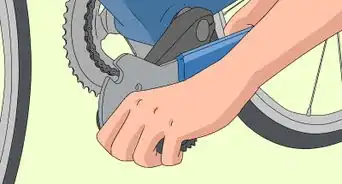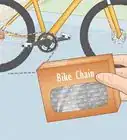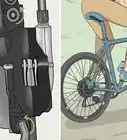This article was co-authored by Jonas Jackel. Jonas Jackel is the Owner of Huckleberry Bicycles, a bicycle retail store based in San Francisco, California. Jonas has over 20 years of experience managing bicycle retail stores and has operated Huckleberry Bicycles since 2011. Huckleberry Bicycles specializes in servicing, repairing, and custom building road, cross, gravel, touring, folding, and e-bikes. Jonas was also previously sat on the Board of Directors for Bike East Bay, a bicycle-advocacy non-profit organization based in Oakland, California.
There are 8 references cited in this article, which can be found at the bottom of the page.
wikiHow marks an article as reader-approved once it receives enough positive feedback. This article received 22 testimonials and 97% of readers who voted found it helpful, earning it our reader-approved status.
This article has been viewed 1,020,632 times.
Have you ever had troubles with your bike switching gears unexpectedly or not shifting correctly? Many people have this problem, but are afraid of attempting to fix it for fear of making things worse. But you don't need to go into the shop to get your bicycle shifting properly. Just adjust the rear derailleur! A good eye and some lubricant should be all you need.
Steps
Fixing Shifting Issues
-
1Prop the bike up so you can spin the wheels as you work. You'll need to either lift the bike into a bike stand or flip the bike over so that it rests on the seat and handlebars. To adjust a derailleur, you'll need to pedal the bike while working.
-
2Shift the bike to the highest possible gear. On the rear axle, the lowest gear (1st) is the largest sprocket, and the highest gear (5th, 6th, 7th depending on how many sprockets are on the cassette) is the smallest sprocket. It is furthest away from the centre line of the bike, or closest to the frame fork. A derailleur works by moving the chain from sprocket to sprocket. The derailleur is connected to the shift lever by a steel cable. The derailleur is moved by tightening or relaxing the cable tension. The highest gear (smallest sprocket) on the rear derailleur is actually the point of lowest cable tension, meaning the derailleur is doing the least work and is thus easiest to adjust.
- While pedaling the bike, locate the cable leading to your rear derailleur and pull on it gently. Note how this shifts the chain by moving the derailleur. All a derailleur does is align the chain with the sprockets on the cassette.
Advertisement -
3Locate the barrel adjuster, then follow this cable through the bike to look for any issues. The barrel adjuster is the small cylinder connecting the cable to the derailleur. Follow your cable from the rear derailleur up to the handlebars. The tension on this cable is what actually causes gears to shift. You need to have the tension in the cable set up correctly to shift from one gear to the next. Make sure it is seated in its housing and isn't bent, loose, or caught in anything. This isn't a common issue, but it happens.[1]
-
4Attempt to shift through all of the gears in both directions, noting any issues. Keep pedalling the bike, shifting gears one at a time. Make a mental note of points where the chain skips a gear or needs to be clicked twice to shift a gear. Does the derailleur have problems going up or down the gears? Is there any noise or grinding?
-
5Return to the highest gear and start shifting until you reach a "problem area," as noted before. For example, if the bike struggles to get from fourth to fifth gear, stop shifting on the fourth gear. While still pedaling, turn the barrel adjuster in the direction you need the cable to fall which, in this case, would be counter-clockwise. Tightening the barrel changes the tension of the cable which, in turn, dictates the gear you're in.[2]
- Note that if the bike is upside-down, you need to turn the barrel away from the direction you want the chain to move. [3]
-
6Rotate the barrel adjuster counter-clockwise to help the chain shift down, towards the larger gears. Loosening the barrel adjuster tightens the cable, making it easier to pull up towards the larger gears. If you shift down and nothing happens, leave it in the shifted gear and keep turning the pedals. Turn the barrel counter-clockwise until the chain jumps up and shifts on its own -- your bike is adjusted.[4]
-
7Rotate the barrel adjuster clockwise to help the chain shift up, towards the lower gears. If your chain struggles to move away from the bike, you can tighten the barrel. If it won't shift when you click it, keep pedalling the bike and rotate the barrel. This decreases the tension on the derailleur, allowing the chain to "fall" smoothly to the higher gears. Keep turning slowly until the chain shifts on its own, matching the gear you just tried to shift to.
- Loosening the barrel also helps if your chain is jumping two gears at once when heading to the larger sprockets.[5]
-
8Check all of the gears by shifting up and down slowly. Once you've adjusted one gear to shift smoothly, the rest of the derailleur usually falls right into place. Check all of the gears to ensure you're adjusted, then move on. If you still have issues:
- Turn the barrel 2-3 turns to the right to full loosen it, then start over. If the cable was too tense when you started, it could need to be re-adjusted from scratch.
- Check for bent gears or derailleur arms. If this didn't work, there is likely a larger issue with the bike.[6]
-
9Lubricate the screws and pivot points with bike grease to prevent further issues. Keep the chain lubricated with special chain lube to ensure that stiff chain links do not affect the shifting, and to make sure that the drive train will last a long time.
Fixing Slipping Chains
-
1Only adjust your limit screws if the chain is popping out on either side of the derailleur. The two screws labeled "L" and "H" are used to adjust your limits. Basically, they determine how far in either direction the chain can travel. Unless you're having issues with the chain falling out, there is no reason to adjust these screws on the rear derailleur (as they were likely set properly at the factory). However, if your bike was in an accident or you installed a new derailleur, these screws may need to be adjusted.
- If you keep slipping a chain, check your limit screws.
- If you can't shift into the highest or lowest gear, check limit screws.
- If your chain is grinding against your frame, check limit screws.[7]
-
2Turn the "H" (high) limit screw clockwise to prevent the chain from moving too far to the right, away from the bike. Of course, you would turn it counter-clockwise if the chain is getting stopped too early. The high limit is for the smallest gear in the rear derailleur.
-
3Turn the "L" (low) limit screw clockwise to prevent the chain from moving too far to the left (and potentially into your wheel). Again, turn it the opposite way (counter-clockwise) if the limit is pushed too far in. On the rear derailleur, the low limit is for the biggest gear.[8]
-
4Shift to the high and low gears, visually confirming that the derailleur is lined up with the center of the gears. Once you've got the limits where you want them, make sure they are lined up nicely. You should see the jockey wheel (metal arm with small cogs under the derailleur) lined up right underneath the chain.[9]
-
5Test both screws and watch to see when the derailleur moves if the H and L are no longer marked. If you are in the furthest gear, you will see the derailleur moving as you adjust the screws. So, if you need to adjust the low limit, shift to the gear on the far left, the biggest one. Adjust both screws a 1/2 turn and notice if the derailleur moves at all. Make sure it lines up in the middle of the gear, then turn back both screws a 1/2 turn so you don't ruin the limits on the correct screw.[10]
Community Q&A
-
QuestionMy rear derailleur does not have a barrel adjuster. How do I adjust it without this?
 Community AnswerUse the tension adjuster at the gear shifter at the handlebars located under the shift system at the base of the cable housing.
Community AnswerUse the tension adjuster at the gear shifter at the handlebars located under the shift system at the base of the cable housing. -
QuestionI have a 7-gear rear derailleur. Recently it started to jump up by 1 gear. For example, if the gear shifter is at 6, it settles into 7 automatically. Moving from 6 to 5 actually moves the gear from 7 to 6. How do I resolve it?
 Community AnswerAdjust your barrel adjuster until it drops into the correct gear, which may require adjusting the cable at its anchor point first.
Community AnswerAdjust your barrel adjuster until it drops into the correct gear, which may require adjusting the cable at its anchor point first. -
QuestionWhat if the cog is spinning without engaging the wheel?
 Community AnswerIf the cog is spinning, it's most likely that the chain itself is out of line. Guide the chain back onto the a gear and hand-pedal it forward gently until it clicks in.
Community AnswerIf the cog is spinning, it's most likely that the chain itself is out of line. Guide the chain back onto the a gear and hand-pedal it forward gently until it clicks in.
Warnings
- Failure in properly adjusting the rear derailleur can cause the chain to slip off, damaging the frame and possibly sending the derailleur into the rear wheel.⧼thumbs_response⧽
- This may be difficult to do if you don't have bicycle repair experience. If you're unsure, go to your nearest favorite bike shop and see if you can get a shop guy to show you how to adjust it.⧼thumbs_response⧽
References
- ↑ https://www.youtube.com/watch?v=Nr-ow1Yvxy4
- ↑ http://www.parktool.com/blog/repair-help/rear-derailleur-adjustment
- ↑ https://www.youtube.com/watch?v=Nr-ow1Yvxy4
- ↑ http://www.parktool.com/blog/repair-help/rear-derailleur-adjustment
- ↑ https://www.youtube.com/watch?v=Nr-ow1Yvxy4
- ↑ http://www.sheldonbrown.com/derailer-adjustment.html
- ↑ https://www.youtube.com/watch?v=KG9H_0aoICM
- ↑ http://madegood.org/bikes/repair/set-a-limit-screw-on-a-rear-derailleur/
- ↑ https://www.youtube.com/watch?v=7xV-ItsgyP0
- ↑ http://www.sheldonbrown.com/derailer-adjustment.html
- Videos provided by Leonard Lee
- How to Adjust a Rear Derailleur - Source of some images and information. Shared with permission.
About This Article
Before adjusting a rear bicycle derailleur, turn your bike upside down so you can spin the wheels as you work. Next, shift the bike to the highest possible gear. Then, locate the barrel adjuster, which is the small cylinder connecting the cable to the derailleur. Follow this cable through the bike to look for any issues, such as the tension being off or the housing being bent. If you find a problem area, turn the barrel adjuster in the direction you need the cable to fall. To learn how to fix a slipped chain, keep reading!
